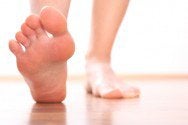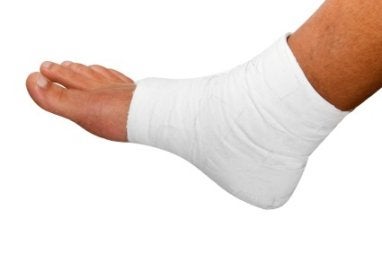-
Everything You Need to Know About Gout
Gout, typically found in diabetic patients, is an unusually painful form of arthritis caused by elevated levels of uric acid in the bloodstream. The condition typically strikes the metatarsal phalangeal joint on the big toe; though it has been known to strike the knees, elbows, fingers, ankles and wrists—generally anywhere that has a functioning, moving joint.
The high level of uric acid in a person’s bloodstream creates the condition known as hyperuricema—the main cause of gout. Genetic predisposition occurs in nine out of ten sufferers and the children of parents who suffer gout will have a two in ten chance of developing the condition as well.
This form of arthritis, again noted as being particularly painful, is the leftover uric acid crystallizing in the blood stream and travel to the space between joints where they rub causing agonizing friction when the patient moves. Symptoms include: pain, redness, swelling, and inflammation. Tertiary side effects may include fatigue and fever though reports of these effects are very rare. Some patients have reported that, as the temperature drops (when you sleep for instance) the pain may intensify.
Most cases of gout are easily diagnosed by a podiatrist’s assessment of the various symptoms, however there are defined tests that can be performed. A blood test to detect elevated levels of uric acid is often used as well as the use of an x-ray to diagnose visible and chronic gout.
Treatment for gout simply means eliminating symptoms; non-steroid anti-inflammatory drugs or NSAIDs (Colchicine and other corticosteroid drugs, etc.) will quell the redness, the swelling, and the inflammation, however, diet, lifestyle changes, and preventative drugs are necessary to fully combat the most severe cases.
Those that lead a sedentary lifestyle are at a higher risk for gout. Any amount of exercise decreases probability of repeat encounters with the condition. Also, staying away from, or reducing drastically, consumption of red meat, sea food, and fructose-sweetened drinks reduces the likelihood of chronic gout as well.
As for diet, beyond what has already been mentioned, ingesting Vitamin C, coffee, and particular dairy products help on the preventative maintenance side of healthy living. While new drugs are out on the market that inhibit the body’s production of uric acid-producing enzymes, reducing or eliminating as much as possible your overall levels of uric acid will ensure you lead a gout-free life.
-
Gout Often Misdiagnosed in Women
 Three years ago Kathleen Sundbye began feeling a painful burning sensation in her right foot that was quickly diagnosed as gout. Accordingly, many women are often misdiagnosed since gout is known to occur more likely in males. In recent years more and more women have been diagnosed with the disease; however, it seems to occur in different areas of the lower extremities compared to men. Most men experience gout pain in their knees, ankles, and feet while women will have it in their knees and toes.
Three years ago Kathleen Sundbye began feeling a painful burning sensation in her right foot that was quickly diagnosed as gout. Accordingly, many women are often misdiagnosed since gout is known to occur more likely in males. In recent years more and more women have been diagnosed with the disease; however, it seems to occur in different areas of the lower extremities compared to men. Most men experience gout pain in their knees, ankles, and feet while women will have it in their knees and toes. Gout is a foot condition that requires certain treatment and care. If you have any concerns regarding gout, consult with Dr. Jon M. Sherman of Kentlands Foot and Ankle Center . Our doctor will assist you with all of your foot and ankle needs.
What is Gout?
Gout is a type of arthritis caused by a buildup of uric acid in the bloodstream. It often develops in the foot, especially the big toe area, although it can manifest in other parts of the body as well. Gout can make walking and standing very painful and is especially common in diabetics and the obese.
People typically get gout because of a poor diet. Genetic predisposition is also a factor. The children of parents who have had gout frequently have a chance of developing it themselves.
Gout can easily be identified by redness and inflammation of the big toe and the surrounding areas of the foot. Other symptoms include extreme fatigue, joint pain, and running high fevers. Sometimes corticosteroid drugs can be prescribed to treat gout, but the best way to combat this disease is to get more exercise and eat a better diet.
If you have any questions, please feel free to contact our office located in Gaithersburg, MD . We offer the newest diagnostic and holistic treatment protocols for all your individual foot and ankle needs.
-
Dealing with Stress Fractures of the Foot and Ankle
Stress fractures occur in the foot and ankle when muscles in those areas are weakened from too much or too little use. When this happens, they stop cushioning the foot and ankles from the impact of hitting the ground. Because there is nothing to protect them, the bones of the foot begin to absorb the full impact of each step someone takes. The added stress causes little cracks to form in the bones that are under the most pressure. These cracks are called stress fractures.Stress fractures are common for individuals whose daily activities cause high levels of impact on their feet and ankles. Individuals who run, play tennis or basketball, or practice gymnastics tend to experience these fractures more frequently. Anyone is susceptible to this problem, though. Individuals who are normally sedentary and suddenly begin an intensive high impact work out may get stress fractures. This is because their muscles are not strong enough to handle and cushion the intensity of their activity. Osteoporosis may also cause someone to get stress fractures, because the disease weakens an afflicted person’s bones and makes it easier for them to break down.
The pain from these fractures will occur in the general area of the fracture. It may be intermittent or constant, and will cause sharp or dull pain along with swelling and tenderness. Engaging in any kind of activity, high impact or otherwise, will aggravate the pain. If the intensity of the activity increases before the stress fracture has properly healed, it can cause a full fracture. This is a much more serious problem, and will probably prevent you from applying any pressure on the foot at all.
Treatment can vary depending on the individual and the degree of injury. The primary way to treat a stress fracture is to rest the hurt foot. Some fractures will heal quickly with only a little bit of rest, while others may require a long rest period and the use of crutches. Under certain circumstances, surgery may be required to install support pins around the fracture to assist in healing.
In order to avoid getting stress fractures, make sure to get plenty of calcium and Vitamin-D. They will help to keep your bones strong, and make them less likely to break under pressure. If your new exercise regimen is running or some other kind of high impact activity, set incremental goals on a weekly basis so you can build up muscle strength. For example, if you plan to walk every day, you could ride a bike on some days to take the stress off of your feet. Make sure to wear supportive shoes to better protect you feet.
If you begin to experience any symptoms of stress fractures, you should stop exercising and rest. If the symptoms do not go away, see an orthopedic specialist. Remembering these tips can help you prevent stress fractures to your foot and ankle, and allow you to continue living normally.
-
Dancing With the Stars Champion Rumer Willis Sustains Stress Fracture
 Rumer Willis, winner of Dancing with the Stars season 20, recently sustained a stress fracture in her left foot keeping her from performing for the remainder of the Dancing With the Stars Live Tour. The 26-year-old actress has been seen out and about sporting a boot to protect the injury of her lower extremity. “I have to hang up my dancing shoes for a little bit because of a few stress fractures in my foot but it’s not going to stop me from singing for you guys on the #DWTSlivetour,” Willis explained.
Rumer Willis, winner of Dancing with the Stars season 20, recently sustained a stress fracture in her left foot keeping her from performing for the remainder of the Dancing With the Stars Live Tour. The 26-year-old actress has been seen out and about sporting a boot to protect the injury of her lower extremity. “I have to hang up my dancing shoes for a little bit because of a few stress fractures in my foot but it’s not going to stop me from singing for you guys on the #DWTSlivetour,” Willis explained. Activities, such as dancing, where too much pressure is put on the feet can cause stress fractures. If you have any concerns about your feet or ankles, contact Jon M. Sherman of Kentlands Foot and Ankle Center . Our doctor will attend to all of your foot and ankle needs and provide you with quality treatment.
Dealing with Stress Fractures of the Foot and Ankle
The Stress Fractures occur on the foot and ankle when muscles in these areas weaken from too much or too little use. Then the feet and ankles lose support when walking or running from the impact of the ground. Since there is no protection the bones receive the full impact of each step. The stress on the feet causes cracks to form in the bones, thus called stress fractures.
What are Stress Fractures?
Stress fractures occur frequently in individuals whose daily activities cause great impact on the feet and ankles. Stress factors are most common among:
– runners
– people affected with Osteoporosis
– play tennis or basketball
– gymnastics
– high impact workouts
Symptoms
Pain from the fractures occur in the area of the fractures, and can be constant or intermittent. It will often cause sharp or dull pain with swelling and tenderness. Engaging in any kind of activity which involves in high impact will aggravate pain.
For more information about Stress Fractures of the Foot and Ankle, follow the link below.
If you have any questions feel free to contact our office located in Gaithersburg, MD . We offer the latest in diagnostic and treatment technology to meet your needs.
Read more about Stress Fractures of the Foot and Ankle
-
Bunions
A bunion is an enlargement of the base joint of the toe that connects to the foot, often formed from a bony growth or a patch of swollen tissues, and is caused by the shifting of the big toe bone inward towards the other toes. This shift can cause a serious amount of pain and discomfort and the area around the big toe will become inflamed, red, and painful.
Bunions are most commonly formed in people who are already genetically predisposed to them or other kinds of bone displacements. However, even if you do not have a history of this in your family, you can still develop bunions if you are wearing improperly fitting shoes, such as trying to cram your feet into high heels, or by running or walking in a way that causes too much stress on the feet. High heels are a major culprit in the formation of bunions because not only do they push the big toe inward, but your body weight and center of gravity is shifted towards the edge of your feet and your toes, which can cause bone displacement.
Bunions are quickly and easily diagnosed by podiatrists. However, because of their nature, they can appear similar to arthritic conditions or gout, so sometimes a blood test is required to fully diagnose a bunion. A full radiological or x-ray exam could also be done by a podiatrist to examine the bone structure of your feet. One thing that is looked for specifically is an enlargement of that base joint or evidence of the big toe bone being pushed inward.
One of the first things to do if you have bunions is to get a larger, wider shoe that can remove pressure from your toes. This usually means that high heels should be eliminated from use for a period of time to allow the bunion to heel. Oftentimes, eliminating the pressure placed on a bunion is enough to eliminate the pain involved with them, however, pain can persist in some instances and anti-inflammatory drugs may be prescribed. If the pain is too severe, steroid injections near the bunion or even surgery may be required. Orthotics for shoes may also be prescribed which can alleviate the pain of bunions by removing pressure from them. However, these methods simply stop the pain of bunions but do not correct the problem at its source.
As previously mentioned, surgery may be an option to completely eliminate your bunions. Surgery is done to reposition the toe bones so that they no longer face inward. This can be done by removing a section of bone or by rearranging the ligaments and tendons in the toe to help them align properly. Even after the surgery, it may be necessary to wear protective shoes for a while to ensure that the bunions do not return.
-
Australian Surgeons Try Out Less Invasive Surgical Method for Bunions
 Australian surgeons are now practicing minimally invasive surgery for bunions to reduce the amount of pain and recovery time for patients. Michelle Thacker of North South Wales experienced both minimally invasive surgery and traditional bunion surgery for the bunions on her left and right feet. The difference between the two are that minimally invasive surgeries include a bunch of smaller 3mm incisions with the bunion drilled and realigned with screws; traditional surgeries include one large incision. After the second bunion surgery using minimally invasive surgery, Thacker stated, “the recovery time was much quicker – a lot less pain post op, I can barely see a scar and I was able to run after three months.”
Australian surgeons are now practicing minimally invasive surgery for bunions to reduce the amount of pain and recovery time for patients. Michelle Thacker of North South Wales experienced both minimally invasive surgery and traditional bunion surgery for the bunions on her left and right feet. The difference between the two are that minimally invasive surgeries include a bunch of smaller 3mm incisions with the bunion drilled and realigned with screws; traditional surgeries include one large incision. After the second bunion surgery using minimally invasive surgery, Thacker stated, “the recovery time was much quicker – a lot less pain post op, I can barely see a scar and I was able to run after three months.” Bunion surgery usually occurs after non-surgical methods have proved to be ineffective. If you have any concerns contact Dr. Jon M. Sherman of Kentlands Foot and Ankle Center . Our doctor will treat your foot and ankle needs.
What is a Bunion?
A bunion is formed of swollen tissue or an enlargement of boney growth, usually located at the base joint of the toe that connects to the foot. The swelling occurs by the bones in the big toe shifting inward, which impacts the other toes of the foot. This causes the area around the base of the big toe to become inflamed and painful.
Why do Bunions Form?
- Genetics – susceptibility to bunions are often hereditary
- Stress on the feet – poorly fitted and uncomfortable footwear that places stress on feet, such as heels, can cause bunions to form
How are Bunions Diagnosed?
Doctors often perform two tests – blood tests and x-rays – when trying to diagnose bunions, especially in the early stages of development. Blood tests help determine if the foot pain is being caused by something else, such as arthritis, while x-rays provide a clear picture of your bone structure to your doctor.
How are Bunions Treated?
- Refrain from wearing heels or similar shoes that cause discomfort
- Select wider shoes that can provide more comfort and reduce pain
- Anti-inflammatory and pain management drugs
- Orthotics or foot inserts
- Surgery
If you have any concerns please feel free to contact our office located in Gaithersburg, MD . We offer the newest diagnostic tools and technology to treat your foot and ankle needs.
-
What to Do to Keep Your Child’s Feet Healthy
Being a parent involves caring for your child in every way you can. You make sure they are eating the right food, being nice to others, and staying out of any trouble. However, it is also important that you are watchful of their health, more specifically their foot health. Maintaining good foot health in childhood is important in preventing later conditions in life from happening. As children continue to develop, their feet require different techniques of care. Here are some various ways in which you can help your child’s feet stay healthy.
A baby needs a lot of care and attention overall, but the importance of their feet should never be forgotten. Before a baby turns one, their feet change and develop greatly. It is important that during this time, a mother avoids putting tight socks on their child and also encourages movement of their feet so the baby can begin to feel more comfortable using them.
As a baby enters the toddler years of his/her life, they are now starting to walk around. When your baby begins to take those first steps, it is crucial that they are wearing protective shoes on their feet. As a mother that is observant of your child’s feet, you may notice changes in them. This is completely normal as the feet are becoming susceptible to the activity of walking. It is normal for a toddler to be a bit unsteady or to “walk funny” at first.
When your child grows out of their toddler years, it is important that you begin to show him/her how to care for their feet on their own. Practice with your child proper hygiene in order to prevent foot fungus or infection. Since children are constantly on the move, it is crucial to be cautious of any accidents or injuries that might occur. If an injury occurs, it is advised that you take your child to be examined by a doctor immediately. Since your child is still growing, particular injuries can shift the way in which a bone or other important part of the foot is developing.
Babies and kids are always changing and growing. Your job as a parent is to make sure they stay healthy and making sure they are properly maintained. This involves proper foot care and making sure the feet stay healthy. Following this guidance , your child can live a long and happy life.
-
Growing Shoe Made to Last Created for Children in Third World Countries
 Children all around the world grow out of their shoes so quickly that many parents, especially, in third world countries, cannot afford to buy their children shoes. The Shoe That Grows , designed by Kenton Lee, was created to combat this problem by allowing the shoe to expand up to five sizes and by lasting up to five years. Lee was inspired when he went on a trip to Kenya and saw many children running around barefoot, making them especially susceptible to diseases and infections. The leather and rubber materials make the shoes especially durable and come in size small (for children grades kindergarten to fourth grade) and size large (grades fifth to ninth).
Children all around the world grow out of their shoes so quickly that many parents, especially, in third world countries, cannot afford to buy their children shoes. The Shoe That Grows , designed by Kenton Lee, was created to combat this problem by allowing the shoe to expand up to five sizes and by lasting up to five years. Lee was inspired when he went on a trip to Kenya and saw many children running around barefoot, making them especially susceptible to diseases and infections. The leather and rubber materials make the shoes especially durable and come in size small (for children grades kindergarten to fourth grade) and size large (grades fifth to ninth). Having shoes for children is essential in allowing them to grow properly and keeping them disease free. If you have any concerns contact Dr. Jon M. Sherman of Kentlands Foot and Ankle Center . Our doctor will treat your foot and ankle needs.
Keeping Children’s Feet Healthy
Having healthy feet in childhood can help prevent medical problems later in life, namely in the back and legs. As children grow, their feet require different types of care from birth to school-age.
Although babies do not walk yet, it is still very important to take care of their feet.
- Avoid putting tight shoes or socks on his or her feet
- Allow the baby to stretch and kick his or her feet to feel comfortable
As a toddler, kids are now on the move and begin to develop differently. At this age toddlers are getting a feel for walking, so don’t be alarmed if your toddler is unsteady or ‘walks funny’. Be sure the child wears comfortable and protective shoes so that they can grow into their feet properly.
As your child gets older, it is important to teach them how to take care of their feet
- Show them proper hygiene to prevent infections such as fungus
- Be watchful of any pain or injury
- Have all injuries checked by a doctor as soon as possible
- Comfortable, protective shoes should always be worn, especially at play
Children of all ages are constantly developing and growing, and as a parent you want to make sure that nothing is hindering their maturation.
If you have any concerns feel free contact our office located in Gaithersburg, MD . We offer the newest diagnostic tools and technology to treat your foot and ankle needs.
Read more about keeping children’s feet healthy.
RECENT POSTS
categories
- Uncategorized
- Featured Articles
- Foot Disorders
- Broken Ankle
- Broken Toe
- Fracture
- Foot Health
- Foot Care
- Arthritis
- Foot Pain
- Skin Cancer
- Podiatry Appointment
- Custom Orthotics
- Podiatrist
- Diabetes
- Gout
- Heart Health
- National Nutrition Month
- National Foot Health Awareness Month
- Foot Safety
- Foot and Ankle Injuries
- Falls Prevention
- Chronic Heel Pain
- Shoes
- Laser Therapy
- Quoted
- Physical Therapy
- KeryFlex
- Sweat
- Summer Foot Care
- Sports Injury
- ESWT
- Fungal Toenails
- Bunion
- Plantar Fasciitis
- PinPointe Laser


